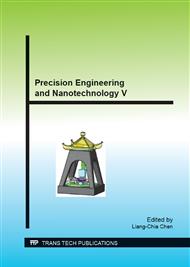[1]
Jiwang Yan, Katsuo Syoji, Jun'ichi Tamaki, Some observations on the wear of diamond tools in ultra-precision cutting of single-crystal silicon, Wear. 255(7-12) (2003) 1380–1387.
DOI: 10.1016/s0043-1648(03)00076-0
Google Scholar
[2]
J.A. Ghani, M. Rizal, M.Z. Nuawi, M.J. Ghazali, C.H.C. Haron, Monitoring online cutting tool wear using low-cost technique and user-friendly GUI, Wear. 271(9–10) (2011) 2619-2624.
DOI: 10.1016/j.wear.2011.01.038
Google Scholar
[3]
Kunpeng Zhu, Yoke San Wong, Geok Soon Hong, Multi-category micro-milling tool wear monitoring with continuous hidden Markov models, Mechanical Systems and Signal Processing. 23(2) (2009) 547-560.
DOI: 10.1016/j.ymssp.2008.04.010
Google Scholar
[4]
F.J. Alonso, D.R. Salgado, Analysis of the structure of vibration signals for tool wear detection. Mechanical Systems and Signal Processing. 22(3) (2008) 735-748.
DOI: 10.1016/j.ymssp.2007.09.012
Google Scholar
[5]
D.R. Salgado, F.J. Alonso, An approach based on current and sound signals for in-process tool wear monitoring, International Journal of Machine Tools and Manufacture. 47(14) (2007) 2140-2152.
DOI: 10.1016/j.ijmachtools.2007.04.013
Google Scholar
[6]
Martín P. Gómez, Alfredo M. Hey, José E. Ruzzante, Carlos E. D'Attellis, Tool wear evaluation in drilling by acoustic emission, Physics Procedia. 3(1) (2010) 819-825.
DOI: 10.1016/j.phpro.2010.01.105
Google Scholar
[7]
H. Shao, H.L. Wang, X.M. Zhao, A cutting power model for tool wear monitoring in milling, International Journal of Machine Tools and Manufacture. 44(14) (2004) 1503-1509.
DOI: 10.1016/j.ijmachtools.2004.05.003
Google Scholar
[8]
S. Kang, J. S. Kim, J. H. Kim et al., A mechanistic model of cutting force in the micro end milling process, Materials Processing Technology. 187-188 (2007) 250-255.
DOI: 10.1016/j.jmatprotec.2006.11.155
Google Scholar
[9]
Bovic Kilundu, PierreDehombreux, XavierChiementin. Tool wear monitoring by machine learning techniques and singular spectrum analysis, Mechanical Systems and Signal Processing. 25(1) (2011) 400–415.
DOI: 10.1016/j.ymssp.2010.07.014
Google Scholar
[10]
Kunpeng Zhu, Yoke San Wong, Geok Soon Hong, Wavelet analysis of sensor signals for tool condition monitoring: A review and some new results, International Journal of Machine Tools and Manufacture. 49(7–8) (2009) 537-553.
DOI: 10.1016/j.ijmachtools.2009.02.003
Google Scholar
[11]
Peng LIU, Jiuhua XU, Yucan FU, Cutting force and its frequency spectrum characteristics in high speed milling of titanium alloy with a polycrystalline diamond tool, Journal of Zhejiang University - Science A, 12(1) (2011) 56-62.
DOI: 10.1631/jzus.a1000408
Google Scholar
[12]
Z. Q. Yin, S. To, W. B. Lee, Wear characteristics of diamond tool in ultraprecision raster milling, International Journal of Advanced Manufacturing Technology. 44 (2009) 638–647.
DOI: 10.1007/s00170-008-1861-2
Google Scholar
[13]
C. Arcona, Th. A. Dow, An Empirical Tool Force Model for Precision Machining, Journal of Manufacturing Science and Engineering. 120(4) (1998) 700-707.
DOI: 10.1115/1.2830209
Google Scholar


